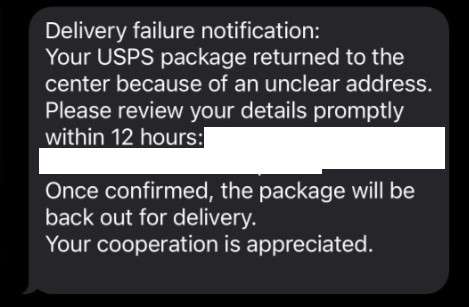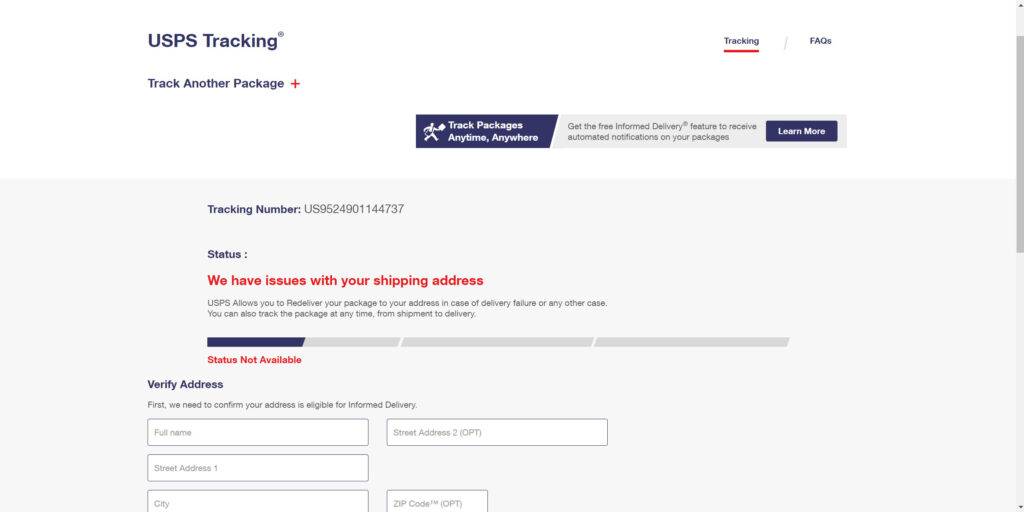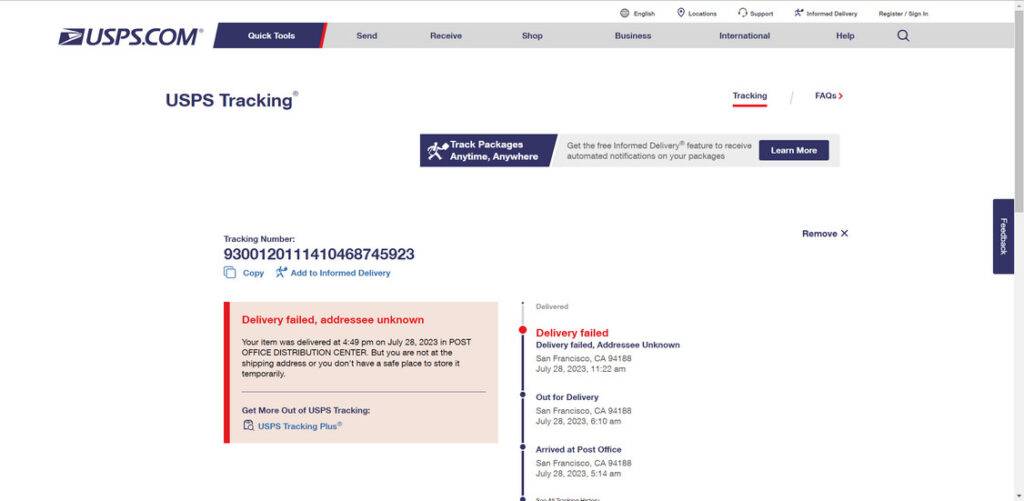Have you received a text message claiming there’s an issue delivering your package #938942521? Don’t rush to confirm your details. This is the latest phishing scam disguising itself as a delivery failure notice to steal your information.
This comprehensive guide will uncover how the “#938942521 Failure Notice” scam texts work, what scammers want, and most vitally, how to guard yourself against their phishing ploys.


What is the USPS Package #938942521 Failure Notice of Delivery Scam?
The “#938942521 Failure Notice of Delivery” scam starts with potential victims receiving a text message stating there is an issue delivering their USPS package #938942521 due to incomplete address details. The message urgently pressures recipients to confirm their info within 12 hours or face delivery delays.
While made to look like a routine USPS delivery error notice, it is actually a phishing scam aiming to steal personal and financial data.
The text includes a link that directs users to a convincing but fake USPS website. The sophisticated site precisely mirrors official USPS branding and graphics to appear valid and build false trust.
Upon arriving at the spoofed website, users are instructed to enter details like full name, date of birth, contact info, and home address in order to “update their delivery profile and avoid further delays.”
After users submit what they believe is simply verifying their address, the fraudulent USPS site then redirects to another phishing page claiming a small redelivery fee must now be paid since addresses were changed. The page requests credit card details to process a $0.23 or similarly small charge.
This secondary payment page strengthens the illusion that USPS genuinely has a package for the user that just needs a routine redelivery fee paid. In reality, it is a scam tactic to steal financial information.
Unfortunately, at no point was USPS actually trying to contact the victims about an undelivered package. The texts, websites and fees are complete fabrications by scammers hoping recipients urgently hand over personal and financial data.
By the end, scammers have gained access to full names, birth dates, contact info, home addresses, and even credit card numbers in some cases.

With these details, criminals can commit identity theft, make unauthorized purchases, or sell the information on the dark web. A wide range of fraud is enabled by the data unknowingly provided by victims.
Because the initial scam texts are sent randomly and untargeted, most recipients have no actual USPS package waiting. But the convincing notices and legitimate-looking sites trick unsuspecting users into providing their information anyway.
In other cases, the scam texts are sent to those who may be more vulnerable to the ploy because they recently placed online orders and are expecting real USPS packages. These individuals are more likely to overlook the red flags because they do have legitimate packages in transit.
Either way, the scammers exploit public familiarity with USPS and its occasional delivery address issues to make the phishing scam seem normal and routine. But USPS would never contact consumers this way and demand sensitive data to fix minor delivery hiccups.
By applying time pressure, requesting unnecessary personal details, and charging small redelivery fees, the scammers increase their chances of tricking hurried users into handing over valuable personal and financial details.
But understanding the scam makes it easier to recognize and report these USPS phishing texts to protect yourself and avoid becoming a victim. Be wary of any messages claiming USPS packages are undeliverable due to address issues and urging you to enter personal data on linked sites.
How the Package #938942521 Failure Notice Scam Actually Works
The scammers behind this fraudulent USPS delivery scam have developed a clever multi-step process to trick unsuspecting victims. Here is a detailed breakdown of how the phishing scam unfolds:
Step 1. Victims Receive a Phishing Text from USPS
The first step involves the scammers sending text messages en masse to random phone numbers. The texts are spoofed to make it appear the message is from USPS.
Here is how it might look:
Notice: Address Update Required. We encounter an issue with your address information which appears unclear or incomplete. Please confirm or update your details within the next 12 hours to proceed without delays.
The text claims there is an issue delivering the recipient’s package #938942521 due to incomplete address details on file with USPS. It states that without confirmation of the recipient’s information, delivery will be delayed.
A sense of urgency is created by noting the details must be confirmed within 12 hours or the package will be sent back. This pressures recipients to act quickly.
Step 2. Victims Click on the Link to the Fake USPS Site
Eager to avoid delays and get their package as soon as possible, victims click the link provided in the text expecting to be sent to the legitimate USPS website.
The link text often says something like “Click here to update your delivery profile and confirm address details with USPS.” But the link actually directs to a sophisticated, yet completely fake website impersonating the real USPS site.

Step 3. The Phishing Site Requests Personal Information
Upon landing on the fraudulent website dressed up to mirror the real USPS site, victims are prompted to enter personal details to “confirm their identity and avoid delivery delays.”
An online form requests they enter their full name, date of birth, phone number, home address, and sometimes other info like Social Security Number.
The phishing site looks professional and convincing, so victims provide the details believing they are simply confirming their profile with USPS to fix the reported address issue.
Step 4. Victims are Redirected to a Fake Payment Page
After victims enter their personal information on the first phishing site, the scammers redirect them to another fraudulent site claiming to be a USPS payment page.
This second phishing site states that because the address needed to be updated in their system, a small redelivery fee is now required before the package can be sent out again. You will see a message like this: “Your package number: 938942521 failure notice of delivery. For redelivery, we need to charge some service fees.”
The page requests credit card information so victims can pay a fee like $0.23 or $1.99 to reschedule the package delivery.
Step 5. Scammers Steal Personal and Financial Details
Unfortunately, at no point in the process was USPS actually attempting to contact the victims about an undelivered package. The texts, websites, and redelivery fees were completely fabricated.
The scammers now have the victims’ personal details like full name, birth date, phone number, home address, and possibly Social Security Number. Plus in some cases they now have credit card numbers as well.
With this sensitive data, the scammers are equipped to commit identity theft, make unauthorized purchases, or sell the details online to other criminals.
Scammers Use Convincing Tactics to Deceive Victims
The scammers behind the USPS Package #938942521 Failure Notice scam employ a variety of deceptive tactics to trick unsuspecting victims:
- Spoofed numbers – The texts come from phone numbers spoofed to appear as legitimate USPS customer service lines.
- Urgent wording – Language like “Respond within 12 hours” creates pressure to act quickly.
- Believable backstory – A failed delivery seems plausible, especially for those awaiting packages.
- Lookalike USPS websites – Phishing sites mimic the real USPS site to build trust.
- Request only necessary info – Asking for name, DOB, address seems harmless to confirm identity.
- Small redelivery fee – A $0.23 fee appears normal and worth paying to get your package.
- Redirects – Redirecting victims across multiple sites adds legitimacy.
Understanding these deceitful tactics makes it easier to recognize this scam before falling victim.
What Information Do Scammers Obtain Through This Scam?
By the time those targeted by this scam reach the end, scammers can gather a significant amount of sensitive personal and financial data, including:
- Full Name – Victims enter first and last name on the address update form.
- Phone Number – Mobile number may be requested on the form or extracted from the original text.
- Home Address – To “update their details”, home address is requested on the form.
- Email Address – Forms often request email in addition to other data.
- Date of Birth – DOB helps enable wider identity theft and fraud.
- Social Security Number – Some forms directly request SSN, while others enable lookup using other details.
- Credit Card Number – The fake redelivery fee page asks for the full credit card number, security code, and expiration to process the “payment”.
With just basic information like your name, DOB, and address, scammers can potentially access your SSN and financial accounts. All data from this scam equips them to steal identities, make illicit purchases, or sell the details online.
Why Do So Many Fall Victim to This Scam?
This highly effective scam manages to deceive victims through a few shrewd techniques:
- Spoofed numbers add legitimacy – Scammers use spoofing to mask scam texts as government agencies or businesses.
- Messages create urgency – The claim of a delivery failure pressures people to act fast to get their items.
- Official logos build trust – The fake sites closely imitate real courier websites’ design and branding.
- Small fee seems benign – A $0.23 redelivery fee appears normal and worth paying to get your package.
- Preys on those expecting packages – Victims waiting for real deliveries overlook the scam indicators.
- Vague tracking details – Most delivery tracking info lacks specifics until in transit, so victims cannot verify package legitimacy.
But recognizing their deceitful tactics makes spotting and avoiding this scam much simpler.
5 Ways to Identify the USPS Package #938942521 Failure Notice Scam
While the texts and websites appear convincing initially, upon closer examination there are subtle signs it’s a phishing scam:
1. Generic greeting lacking your name – Valid notices address you by name, while scam texts remain generic.
2. No specific package details – Real notices would include tracking or order specifics, but scams stay vague.
3. Grammatical errors and typos – Legitimate delivery carriers would not have awkward syntax or misspellings.
4. Requests for unnecessary personal information – Carriers would not need your DOB or SSN just for address confirmation.
5. Threat of delivery failure – Carriers would not threaten you; they would simply attempt delivery again later.
What to Do If You Receive a Suspicious Delivery Carrier Text
If you get a questionable text message claiming to be from USPS about an undeliverable package, take measures to protect yourself:
- Do NOT click any links in the text – The link could direct you to a fake USPS phishing site to steal your data. Links may also contain malware.
- Check the sender’s number – Look up the official USPS customer service number independently rather than calling a number supplied in the text. Verify the text actually came from a valid USPS number.
- Review the message details – Look for phishing red flags like threats about package delivery failure, requests for personal info, or mention of unusual fees.
- Contact USPS customer service – Call the legitimate USPS phone number. Ask if they actually have an undelivered package for you and tried to contact you about it.
- Carefully inspect any sites – If you click a link, thoroughly verify the site matches the real USPS site and has valid contact info and encryption.
- Report the suspicious text – Forward the phishing text to SPAM (7726) so USPS can document the scam attempt and block the sender.
- Delete the questionable text – Remove the phishing text from your messaging app immediately after reporting it to avoid accidental clicks later.
- Monitor your accounts and credit – Watch closely for any unauthorized access or identity theft stemming from the phishing text over the next few weeks.
- Change account passwords if compromised – If you mistakenly provided sensitive info to a scammer, change your passwords for those accounts ASAP.
Being cautious around USPS texts guards you from getting duped by phishing scams aiming to steal your personal details. Only address delivery issues through official USPS channels, never by clicking links or submitting data from unsolicited texts. Stay alert!
What to Do If You Already Fell for the USPS Package #938942521 Scam
If you already supplied personal or financial data to the scammers, take these measures immediately to reduce damages:
- Contact your bank and credit card companies – Notify them of any fraudulent charges and request replacement cards.
- Implement fraud alerts – Contact the credit bureaus to place fraud alerts on your credit reports.
- Monitor your credit reports and accounts – Watch closely for any signs of misuse of your details and identity theft.
- Update account passwords – Change passwords and security questions for any accounts where you reused passwords.
- File an FTC complaint – Submit a report with the FTC outlining how scammers compromised your information.
Tips to Avoid Delivery Scams
Beyond just this particular scam, utilize these proactive recommendations to safeguard yourself from phishing texts and calls posing as delivery carriers:
- Never click links in unexpected texts – Manually look up sites instead.
- Only provide personal information when you initiated the call.
- Independently track packages via official carrier websites.
- Avoid phone numbers in texts – find official contact info yourself.
- Government agencies and carriers won’t contact you unprompted demanding sensitive personal or financial details.
- Carefully inspect sites for subtle differences from legitimate websites.
- Never pay questionable fees with retail gift cards – it’s always a scam tactic.
Staying vigilant against delivery scams keeps your personal and financial data protected.
Frequently Asked Questions About the USPS Package #938942521 Failure Notice Scam
1. What is the USPS Package #938942521 Failure Notice scam?
This phishing scam starts with potential victims receiving a text claiming there’s an issue delivering their USPS package #938942521 due to address problems. The text urges victims to confirm their details within 12 hours on a linked site to avoid delays. However, the site is fake and aims to steal personal and financial information.
2. How does the USPS #938942521 scam work?
Scammers send texts en masse with a link to a phishing site impersonating the real USPS site. Victims enter personal details to “update their profile.” They are redirected to another fake USPS page requesting credit card info to pay a small redelivery fee. In reality, it is all fabricated to steal victims’ details.
3. What techniques do the scammers use?
The scammers use convincing USPS branding, apply time pressure, request unnecessary personal details, charge small redelivery fees, and redirect victims across multiple fake sites to trick them into providing their information.
4. What are signs it’s a scam?
Signs include generic greetings without your name, lack of order specifics, grammatical errors, requests for unnecessary personal details, threats of delivery failure, and links to sketchy sites.
5. What should I do if I get a suspicious USPS text?
Do not click any links. Manually look up USPS contact info and call to verify if they contacted you and have a package. Report the phishing text to 7726. Delete the text.
6. What if I already provided my information?
If you supplied personal or financial details, contact your bank and credit card companies immediately. Place fraud alerts on your credit reports and closely monitor your accounts for any suspicious activity.
7. How can I avoid delivery scams in the future?
Tips include not clicking links in texts, independently looking up official contact information, tracking packages only on legitimate carrier sites, and never providing personal information when you did not initiate contact.
8. Are delivery scams illegal?
Yes, phishing scams aiming to steal personal information and identities by deception are illegal. You can report the scammers to the FTC to aid investigations.
9. How can I protect myself from USPS scams?
Be wary of texts claiming packages are undeliverable and asking you to enter info on linked sites. Only correct delivery issues by contacting USPS directly through official channels.
10. Who is most at risk for the USPS failure notice scam?
Those more vulnerable are people expecting real packages who overlook red flags, as well as elderly individuals less able to identify phishing scams. But anyone contacted randomly can be targeted.
The Bottom Line – Don’t Let Scammers Trick You
This USPS package #938942521 failure notice scam may seem credible thanks to official-seeming messages and convincing spoofed websites. But understanding the detailed tactics these scammers employ allows you to detect red flags and safeguard your sensitive information.
Legitimate couriers will never contact you unsolicited claiming a package is undeliverable and demanding personal details or fees. Any such texts are scammers hoping you’ll act fast and hand over your data. But remaining calm and verifying things independently prevents you from getting duped.
If you received a questionable delivery carrier text, cease contact right away. Never provide the scammers with any personal or financial particulars. Report the scam text to help others avoid the same phishing ploy. With awareness of their manipulative tricks, you can identify and evade delivery scams seeking to steal your hard-earned money and identity. Don’t become another victim of the package #938942521 failure notice scam.










